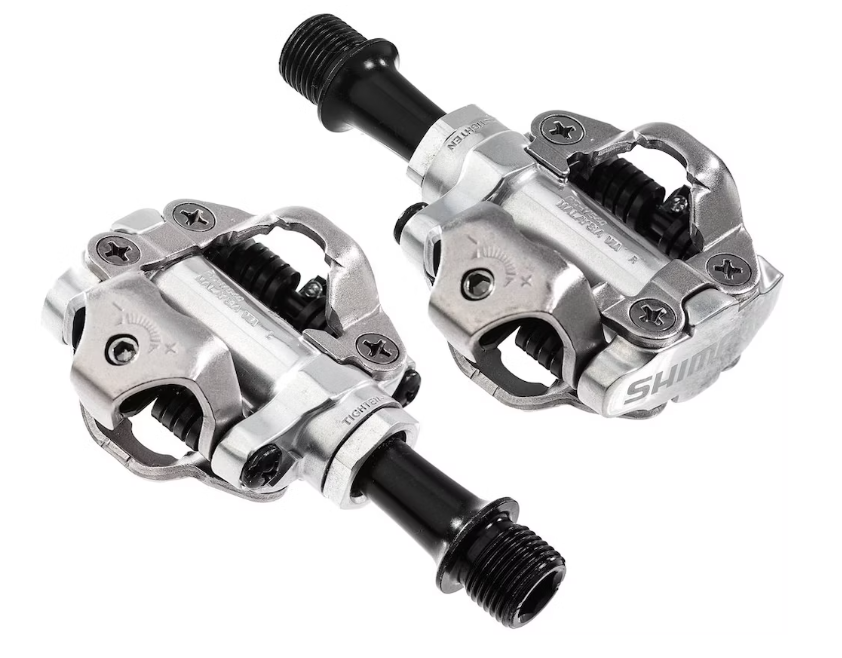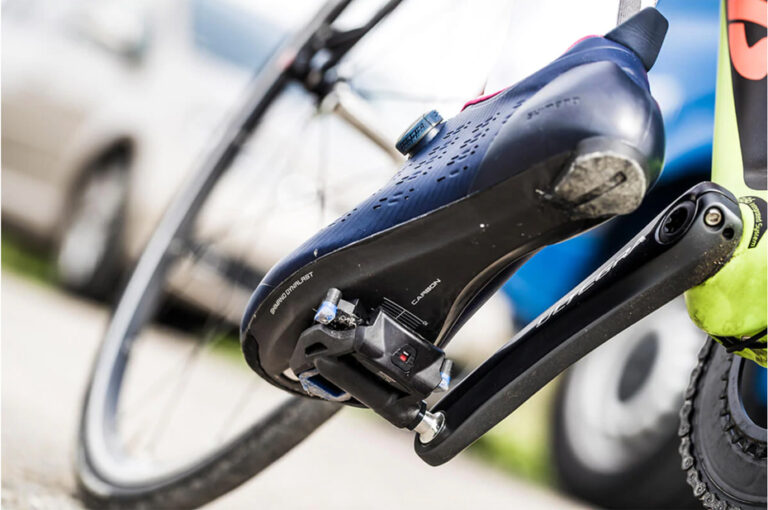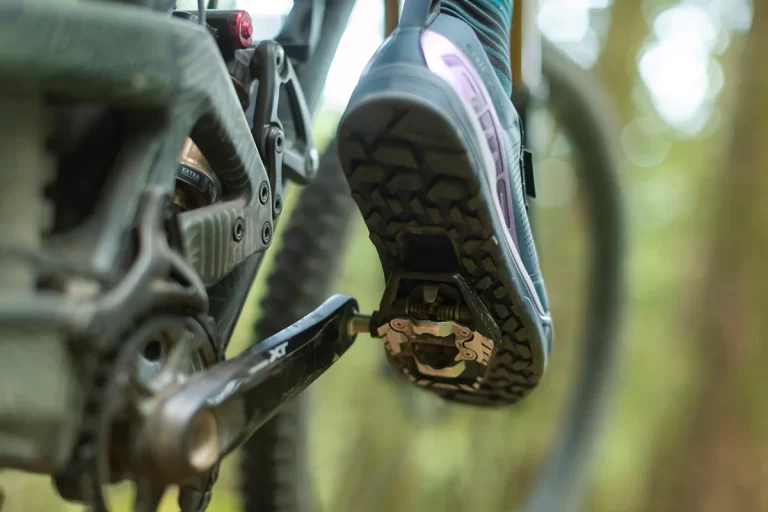Gravel Bike Pedals Buyers Guide

Key Point Summary of this Gravel Bike Pedals Buyers Guide
Choosing the Right Gravel Bike Pedals: Select pedals based on your specific gravel biking needs, considering pedal type (flat, clipless, hybrid), material durability, grip, cleat compatibility, weight, maintenance, comfort, mud-shedding ability, walkability, and price.
Flat Pedals: Ideal for beginners, offering simplicity and ease of use, but less efficient in power transfer and may slip in wet conditions.
Clipless Pedals: Enhance pedaling efficiency and control; require compatible shoes, with MTB-style favored for gravel biking.
Hybrid Pedals: Offer versatility with features of both flat and clipless, but may not excel in specific functions like dedicated types.
Key Features: Focus on durability, appropriate grip, cleat compatibility (like SPD for gravel), balance of weight and durability, ease of maintenance, comfort, efficient mud shedding, and walkability for off-bike sections, while considering budget constraints.
Selecting the right pedals for your gravel bike is crucial as it significantly impacts your comfort and performance on mixed terrains. Gravel biking often combines aspects of road and mountain biking, requiring pedals that are versatile enough to handle various conditions. This Gravel Bike Pedals Buyers Guide should help you select the right pedal.
Types of Pedals for Gravel Biking
Flat Pedals
- Description: Platform pedals with a flat surface and typically no clip-in mechanism.
- Advantages: Excellent for beginners or riders who prefer the ease of wearing any shoe type. They offer simplicity, and immediate foot removal, and are user-friendly.
- Disadvantages: Less efficient power transfer and potential for foot slippage, particularly in wet or muddy conditions.
Clipless Pedals
- Description: Pedals that allow shoes to securely clip in, creating a firm attachment between the shoe and pedal.
- Types:
- MTB-Style (e.g., SPD): Double-sided, durable, and designed to shed mud effectively. They also allow easier walking due to the recessed cleat design.
- Road-Style: Typically have a larger platform for better power transfer but are less practical for walking and mud clearance.
- Advantages: Provide enhanced pedaling efficiency, better control, and consistent foot positioning.
- Disadvantages: Require cycling-specific shoes with compatible cleats, and some riders may find them tricky to use, especially on technical or unpredictable gravel routes.
Hybrid Pedals
- Description: A combination of flat and clipless pedal features, offering dual functionality.
- Advantages: Versatile for riders who switch between casual and more performance-oriented riding. Useful in changing gravel biking conditions.
- Disadvantages: Tend to be heavier and may not offer the full benefits of dedicated clipless or flat pedals.
Key Features to Consider
Material and Durability
- Materials like aluminum, steel, or high-strength composites offer durability for rough gravel terrains. The pedal material affects not only the strength but also the weight and overall feel.
Grip (For Flat and Hybrid Pedals)
- Crucial for maintaining foot stability, especially on uneven gravel surfaces. Look for pedals with a textured surface or pins to enhance grip.
Cleat Compatibility (For Clipless and Hybrid Pedals)
- Common systems include SPD (common in MTB pedals) and SPD-SL or Look (found in road pedals). SPD is generally preferred for gravel due to its versatility and ease of walking.
Weight
- Lighter pedals can reduce overall bike weight, which can be a factor on longer rides. However, the lightest pedals might not always be the most durable, so balance these aspects.
Maintenance and Serviceability
- Gravel riding can be hard on gear. Choose pedals that can be easily serviced, with replaceable parts like bearings or pins.
Comfort and Ergonomics
- The pedal’s platform size and shape should suit your foot size and riding style. Comfort is vital for long gravel rides.
Mud Shedding (For Clipless Pedals)
- If riding in muddy conditions, look for clipless pedals that shed mud efficiently to ensure easy clipping in and out.
Walkability (For Clipless Pedals)
- If your gravel rides include off-bike sections, consider how easy it is to walk in the cleats. Mountain bike-style (SPD) cleats are typically more walkable.
Price
- Gravel bike pedals range from budget-friendly to premium. Your choice should balance cost with the necessary features for your riding style.
Conclusion
The key is to consider how each pedal type will fit into your typical riding scenarios. For instance, if you frequently encounter muddy conditions, clipless pedals with good mud-shedding capabilities and ease of clipping in and out would be beneficial. On the other hand, if you’re riding involves frequent stops or you prefer the safety of easy foot removal, flat pedals might be more appropriate.
Additionally, remember that comfort is crucial. The right pedal should feel natural and comfortable throughout your ride, minimizing foot fatigue and maximizing enjoyment.
Finally, while budget is an important consideration, investing in a quality pair of pedals can enhance your overall riding experience and may save money in the long run through durability and reduced maintenance needs.
In sum, the best gravel bike pedals for you are those that match your riding style, provide the features you need, and offer the comfort and reliability to enjoy your rides fully.
Top Gravel Bike Pedal Manufacturers
FAQ’s
Gravel Bike Pedals Buyers Guide-What kind of pedals should I get for a gravel bike?
Choosing the right pedals for a gravel bike depends on several factors, including your riding style, experience level, and the conditions you typically ride in. Here are some considerations to help you make the best choice:
1. Riding Style and Preference
- Aggressive or Performance-Oriented Riding: If you’re riding aggressively or are more performance-oriented (e.g., long rides, racing), clipless pedals can provide better efficiency and power transfer. They keep your feet securely attached to the pedals, allowing for more consistent pedaling, especially on uphill or challenging terrains.
- Casual or Mixed Riding: If you’re more into casual riding, or if your gravel rides include a mix of cycling and walking, flat pedals or hybrid pedals might be more suitable. They offer the flexibility to use any shoes and make it easy to dismount in varied terrains.
2. Comfort and Efficiency
- Flat Pedals: Offer comfort and ease, especially for those who may not be comfortable with being clipped into the bike. They allow for quick foot removal, which can be advantageous on technical or unpredictable gravel routes.
- Clipless Pedals: Generally offer better pedaling efficiency. For gravel riding, many riders prefer mountain bike-style clipless pedals (like SPDs) because they are easier to clip in and out of and better for walking.
3. Shoe Compatibility
- Ensure the pedal’s cleat system is compatible with your shoes. For clipless pedals, the shoe must have the right cleat mount. If you’re buying new pedals and shoes together, this is less of a concern, but it’s crucial if you’re matching new pedals to existing shoes.
4. Terrain and Conditions
- Consider the types of surfaces and conditions you’ll be riding in. If you’re often in muddy or variable conditions, look for pedals that shed mud and debris well. In this case, mountain bike-style clipless pedals are typically a good choice.
5. Experience Level
- If you’re new to cycling or not comfortable with clipless pedals, starting with flat pedals might be a good idea. You can always transition to clipless pedals as you gain confidence and experience.
6. Budget and Quality
- Pedal prices range from budget-friendly to high-end. While it’s important to stay within your budget, investing in a quality pair of pedals can enhance your riding experience and may offer better durability and performance.
Conclusion
There’s no one-size-fits-all answer for the best pedals for a gravel bike. The decision should be based on a combination of your riding style, the typical conditions you’ll be facing, your comfort with different pedal types, and your budget. Whether you choose flat, clipless, or hybrid pedals, the right choice will make your gravel biking experience more enjoyable and comfortable.
Gravel Bike Pedals Buyers Guide-How do I know what pedals to get for my bike?
Choosing the right pedals for your bike depends on several key factors including your bike type, riding style, and personal preferences. Here’s a guide to help you decide:
Determine Your Riding Style
- Road Biking: If you’re primarily road biking, look for lightweight, aerodynamic pedals. Road cyclists often prefer clipless pedals for their efficiency and power transfer.
- Mountain Biking: For mountain biking, choose between flat pedals for better control in technical terrains and clipless pedals for improved efficiency on climbs and longer rides.
- Commuting or Casual Riding: For commuting or casual riding, flat pedals or cage pedals are practical, as they don’t require special shoes and allow for easy on-and-off.
Consider Pedal Type
- Flat Pedals: Ideal for beginners and those who want easy foot removal, are versatile, and don’t require cycling-specific shoes.
- Clipless Pedals: Lock your foot in place for better efficiency. They come in different systems like SPD, Look, or Time, so ensure compatibility with your shoes.
- Toe Clips or Straps: These can be added to flat pedals for a bit more efficiency while still allowing regular shoes.
Check Compatibility with Your Bike
- Most pedals use a standard 9/16-inch thread, but some older or lower-end bikes might use a 1/2-inch thread.
- Ensure the pedals match the aesthetic and performance level of the bike, especially for road bikes.
- For mountain bikes, consider the pedal’s ability to shed mud and its durability.
Evaluate Material and Weight
- Pedals come in materials like plastic, aluminum, and carbon fiber. Lighter materials are more expensive but offer performance benefits.
- Heavier, more durable materials might be more suitable for casual use.
Consider Your Shoes
- If choosing clipless pedals, you need compatible shoes. For flat pedals, any shoe will work, but those with a flat, stiff sole provide better performance.
Think About Comfort and Ergonomics
- Some pedals offer a wider platform or more grip, which can be more comfortable and efficient.
- Look for pedals and cleats offering adjustability if you have specific ergonomic needs, like knee or foot alignment.
Safety Features
- Reflectors for visibility if riding often in low-light conditions.
- Adjustable tension settings for clipless pedals can make clipping in and out easier, especially for beginners.
Budget
- Pedals range from very affordable to quite expensive. Balance your budget with your needs and the level of biking you intend to do.
Final Thoughts
- It’s often a matter of personal preference based on your cycling habits.
- Consider trying different types to see what feels most comfortable and suits your riding style.
- Remember that you can always change pedals if your needs or preferences change over time.
Gravel Bike Pedals Buyers Guide-Do expensive pedals make a difference?
Expensive pedals can make a difference, but whether this difference is significant for you depends on your level of cycling, the type of riding you do, and what you expect from the pedals. Here are some factors where expensive pedals might make a difference:
1. Performance and Efficiency
- Higher-end pedals often provide better performance in terms of power transfer and efficiency. This can be particularly noticeable in competitive cycling or long-distance rides.
2. Material Quality and Durability
- Expensive pedals are typically made with higher quality materials, which can offer better durability and strength. This is important in demanding cycling conditions, such as mountain biking or competitive road cycling.
3. Weight
- Lighter materials like carbon fiber or high-grade aluminum are often used in more expensive pedals, reducing the overall weight. For serious cyclists, especially those who race, reducing bike weight can offer a performance advantage.
4. Bearings and Smoothness of Operation
- High-end pedals may have superior bearings and better construction, leading to smoother operation and longer lifespan.
5. Maintenance and Serviceability
- More expensive pedals often come with the ability to be serviced and have replaceable parts, which can prolong their life and potentially make them more cost-effective in the long run.
6. Comfort and Ergonomics
- Some expensive pedals offer better ergonomics, which can be important for long rides or if you have specific biomechanical requirements.
7. Cleat System and Engagement
- Higher-priced pedals may have a more sophisticated cleat system, offering a more secure engagement and disengagement, which can be crucial for safety and performance.
Conclusion
- Expensive pedals can offer benefits in terms of performance, durability, weight, and comfort. However, whether these improvements justify the cost will depend on your individual needs and level of cycling.
- For casual or recreational cyclists, mid-range pedals may provide all the necessary functionality without the high cost.
- It’s important to weigh the cost against the actual benefits based on your riding style, frequency, and what improvements you’re seeking in your cycling experience.
Gravel Bike Pedals Buyers Guide-What is the alternative to Shimano SPD?
If you’re looking for alternatives to Shimano SPD pedals, there are several other pedal systems and brands that offer similar functionality with their own unique features. Here are some notable alternatives:
Crankbrothers
- Models like Candy, Eggbeater, Mallet: Known for their distinctive design, these pedals are popular among mountain bikers and cyclocross riders. They offer 4-sided entry which can be easier in muddy conditions and have a unique float and release feel.
Time ATAC
- Various models available: Time pedals are known for their easy engagement and disengagement mechanism, which is gentle on the knees due to rotational freedom (float). They’re also well-regarded for their ability to clear mud effectively.
Look
- MTB Pedals (Look X-Track): Though Look is more famous for its road bike pedals, they also offer mountain bike pedals that compete with SPDs. These pedals are praised for their durability and efficient power transfer.
HT Components
- Various models: HT offers a range of pedals with different platform sizes and pin configurations. They are known for their lightweight designs and are popular in the downhill and enduro scenes.
Ritchey
- Paradigm and other models: Ritchey’s pedals are often appreciated for their reliability and functionality, offering a good balance of performance and price.
Wellgo
- Various models: Wellgo provides a wide range of pedals, including some that are SPD compatible, at often more budget-friendly prices. They are a good option for those looking for a cost-effective alternative.
VP Components
- VP-VICE and others: VP Components offers a range of pedals including some that are SPD compatible. They are known for their durability and solid performance.
Points to Consider
- Cleat Compatibility: Some of these alternatives use their own cleat system, so you’ll need to ensure that your shoes are compatible or be prepared to change cleats.
- Intended Use: Consider what type of riding you’ll be doing (e.g., mountain biking, cyclocross, touring) as different pedals offer different advantages.
- Float and Tension Adjustment: Different pedal systems offer varying degrees of float (foot movement on the pedal) and tension adjustment for clipping in and out, which can impact comfort and performance.
Conclusion
While Shimano SPD pedals are widely used and highly regarded, these alternatives provide various options that cater to different preferences and requirements in pedal feel, engagement/disengagement mechanism, weight, and price. It’s worth exploring these options to find the one that best suits your riding style and needs.





